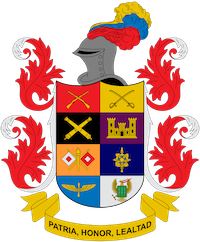Multivariate index for measuring colombia's internal conflict
Abstract
This document aims to contribute to the study of territorial conflict through measurement tools, which have not been developed for the study of the armed conflict in Colombia, with the aim of providing analytical resources that are better adjusted to the specificity of each selected variable that is linked to the time of conflict that is intended to be studied: The result of this research will be the Multivariate Index of Measurement of the Colombian Internal Conflict that will account for the level of conflict of each place that we analyze after the signing of the agreements. Colombia currently does not have a study of this type, emphasizing on the issue of Territorial Conflict, it is known that there are similar measurements, however, none with the orientation that the current investigation intends.
A mixed methodology was included, in the first instance, the review of existing information from studies and research on both the Colombian conflict and the development of the peace process. On the other hand, an analysis of main components was carried out to reduce the information and later the application of a multiple regression model, which allowed determining that there has been a resurgence of the conflict from 2014 to 2021.
Downloads
References
Bedoya, J., Calero, O., Tejada, L., & Rodríguez, H. (2022). Efecto del número de hectáreas de coca cultivadas, incautaciones de pasta de coca y el número de habitantes sobre los depósitos realizados en el sistema bancario durante 2010 a 2017. Perspectivas en Inteligencia, 13(22), 175-200. https://doi.org/10.47961/2145194X.279
Beyer, A. C. (2018). Peace in International Relation. A Journal of Social Justice, 87-94. https://doi.org/10.1080/10402659.2017.1418704
Buendía, E. (2013). El papel de la Ventaja Competitiva en el desarrollo económico de los países. Análisis Económico, 55-78.
Datosmacro. (27 de octubre de 2018). Expansión. Obtenido de https://datosmacro.expansion.com/demografia/indice-paz-global
El Instituto Mexicano para la Competitividad. (23 de octubre de 2018). imco.org.mx. Obtenido de https://imco.org.mx/seguridad/indice-de-paz-mexico-2016-via-el-instituto-para-la-economia-y-la-paz/
Ghazalian, P., & Hammoud, M. (2021). The Peace Level of Nations: An Empirical Investigation into the Determining Factors. Defence and Peace Economics, 509-532. https://doi.org/10.1080/10242694.2020.1743957
Galtung, J. (2003). Paz por medios pacíficos. Paz y conflicto, desarrollo. En J. Galtung, Paz por medios pacíficos. Paz y conflicto, desarrollo (págs. 125-159). Bakeaz.
Global Peace Index: Methodology. (11 de octubre de 2007). Vision Of Humanitary. Obtenido de https://web.archive.org/web/20071011205753/http://visionofhumanity.com/WPI_Methodology/index.php
González, C. (2010). Iniciativas de paz en Colombia. Civilizar Ciencias Sociales y Humanas, 35-54. https://doi.org/10.22518/16578953.15
González, M. (2017). Desarrollo sostenible y paz positiva: Un análisis desde las metas de desarrollo sostenible de la Organización de las Naciones Unidas. En D. E. García, Razones para la PAZ (págs. 135-170). Puebla.
Harto, F. (2016). La construcción del concepto de paz. Cuadernos de estrategia, 119-146.
Hernández, J., Cerpa, A., & Molina, O. (2020). Marco jurídico de la paz en Colombia. Una revisón sistemática y crítica. Justicia, 232-242. https://doi.org/10.17081/just.25.38.4485
Hernández, J., Chumaceiro, A., Ziritt, G., & Acurero, M. (2018). Cultura para la paz en Colombia. Una. Revista de Ciencias Humanas y Sociales, 612-641.
ICRN, O. F. (2014). Índice de Condiciones para la Reconciliación: San Carlos. En O. F. ICRN. Bogotá. Jubitz Family Fundation. (29 de junio de 2017). Jubitz Family Fundation. Obtenido de: https://www.jubitz.org/peace.
Índice de Riesgo de Victimización. Unidad para la Atención y Reparación Integral de las Víctimas.
Instituto Catalán Internacional para la Paz. (2010). MIDIENDO LA PAZ, INICIATIVAS, LIMITACIONES Y PROPUESTAS. Barcelona: Instituto Catalán Internacional para la Paz 2010.
Jiménez, G. (2014). Multinacionales y responsabilidad social empresarial en la construcción de paz en Colombia. Cuadernos de Administración, 67-96.
Mesa, M. (2011). Medir la paz y el desarrollo: nuevas miradas sobre la realidad. Madrid: Centro de Educación e Investigación para la Paz (CEIPAZ).
Sarangi, U. (2018). GLOBAL PEACE INDEX OF ECONOMIES. New Delhi: Goverment of India.
Schill, R., Snow, M., Mellado, R., & Schill, A. (2021). SOCIETAL VARIABLES AND NATIONAL CORRUPTION EFFECTS ON GDP. International Journal on World Peace, 7-27. https://doi.org/10.28945/4843
Ríos, J., & Cairo, H. (2018). Los discursos sobre la participación política. Revista Iberoamericana de Filosofía, Política y Humanidades, 317-339. https://doi.org/10.12795/araucaria.2018.i39.16
Taheri, M. A., & Dehghan, M. (2014). Definition of peace and its different types as approached by Halqeh mysticism. Social and Behavioral Sciences, 56-61. https://doi.org/10.1016/j.sbspro.2013.12.656
Urdaneta, A., Prieto, R., & Pitre, R. (2017). MODELO DE TOMA DE DECISIONES BASADO EN LA DINÁMICA DE SISTEMAS APLICADO A ÍNDICES DE PAZ DE MÉXICO. En LA CIENCIA Y LA EDUCACIÓN ESCENARIO PARA LA CONSTRUCCIÓN DE PAZ (págs. 2005-2026). Universidad de La Guajira.
Verbeek, P. (2008). Peace ethology. Behaviour, 1497-1524 https://doi.org/10.1163/156853908786131270
Viveros, M. (2016). Correlación del índice global de paz con el índice de desarollo humano. Colección Académica de Ciencias Sociales, 18-25.
Voukelatou, V., Pappalardo, L., Miliou, I., Gabrielli, L., & Giannotti, F. (2020). Estimating countries'peace indez through the lens of the world news as monitored gy GDELT. 2020 IEEE 7th International Conference on Data Science and Advanced Analytics (DSAA), 216-225. https://doi.org/10.1109/DSAA49011.2020.00034

This work is licensed under a Creative Commons Attribution-NonCommercial-NoDerivatives 4.0 International License.













